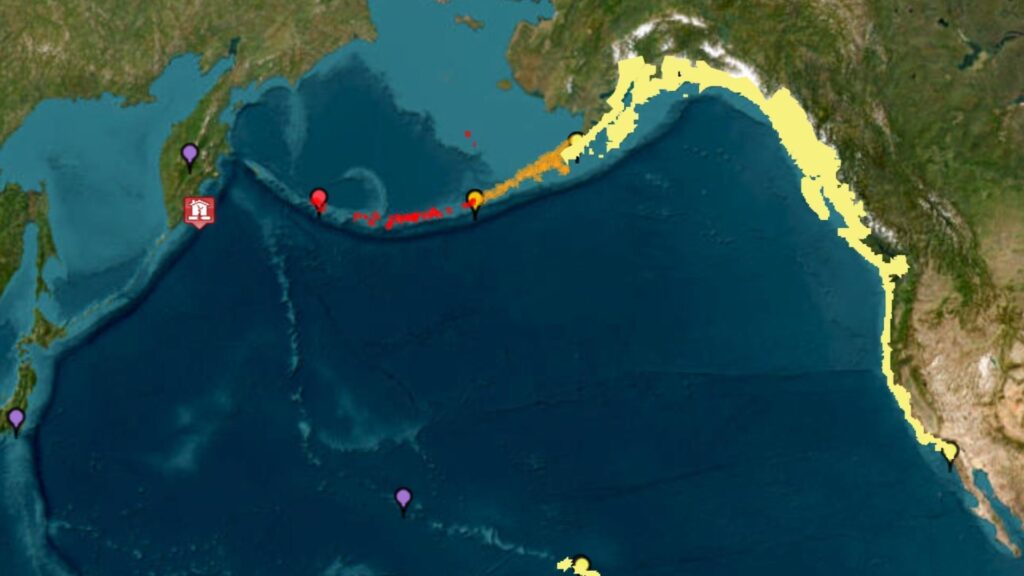
A powerful 8.8-magnitude earthquake off the eastern coast of Russia’s Kamchatka Peninsula on July 29, 2025 (July 30 local time) triggered a wave of tsunami warnings and advisories throughout the Pacific, with the most significant effects occurring in Hawaii, Alaska, Japan, and Russia’s own Far East.
- Magnitude: 8.8 (updated from initial reports of 8.0–8.7)
- Epicenter: About 136 kilometers (85 miles) east-southeast of Petropavlovsk-Kamchatsky, Russia
- Depth: Approximately 20 kilometers (12 miles) below the ocean floor
- Type: Megathrust earthquake on the subduction zone interface, which has historically been a hot spot for strong earthquakes, where the Pacific Plate plunges beneath the Okhotsk Sea Plate.
- Cities close to the epicenter, such as Petropavlovsk-Kamchatsky, experienced violent shaking.
- There were brief power outages, swinging cars in the streets, broken glass, and toppled furniture for the residents.
- In preparation for the tsunami, some coastal regions in the Far East of Russia experienced emergency evacuations.
- Although there were no initial reports of casualties, some buildings had structural damage.
- Hawaii: Sirens sounded throughout the islands as part of an official tsunami warning. Orders to evacuate along the coast were promptly carried out. The Pacific Tsunami Warning Center warned that tsunami waves could hit all Hawaiian Island shores, possibly encircling and flooding coastal areas, necessitating immediate action to save lives and property.
- Alaska: A tsunami warning was issued for portions of the Aleutian Islands, and advisories were issued for a sizable portion of the state’s southern coast. The waves might come in a few hours.
- Japan: As the magnitude of the earthquake became clearer, the Japanese meteorological agency upgraded its initial forecast and issued a tsunami advisory. Vulnerable coastal residents were ordered to evacuate as waves as high as 3–4 meters (10–13 feet) were predicted in some areas.
- Other Pacific Locations: Guam and portions of Micronesia, as well as the U.S. West Coast (California, Oregon, and Washington), were all under warning and advisory, and they were all kept an eye out for any indications of impending tsunami activity.
- By 7:17 p.m. local time, the first potential tsunami waves could arrive on the islands, according to the Hawaii Emergency Management Agency. It was underlined that dangerous surges might persist for several hours following the initial impact and that not all waves would be the biggest.
- Because tsunami waves propagate in a circle and wrap around islands, all shores, regardless of orientation, were deemed vulnerable.
- Even after the first wave, people were cautioned not to go near the coast or river mouths because later waves are frequently stronger or higher.
- Since the 2011 Tōhoku (Japan) tragedy, the 2025 Kamchatka earthquake has been the strongest in the world.
- The area’s seismic vulnerability is highlighted by the region’s notable history of massive earthquakes and tsunamis, including the 1952 Kamchatka event.
- Pacific-wide civil defense officials advised locals to evacuate to higher ground and stay away from all low-lying coastal areas.
- The Pacific Tsunami Warning Center, USGS, and local agencies continue to monitor, provide regular updates, and assess incoming wave heights; emergency services in affected countries are still on high alert.
This incident emphasizes how crucial it is for the Pacific basin to have emergency preparedness, public alert systems, and quick earthquake and tsunami detection.